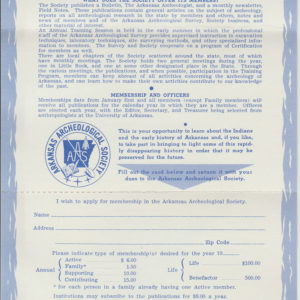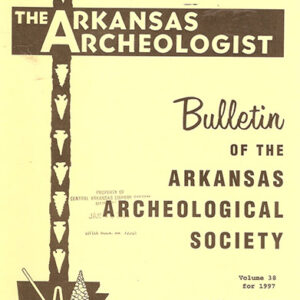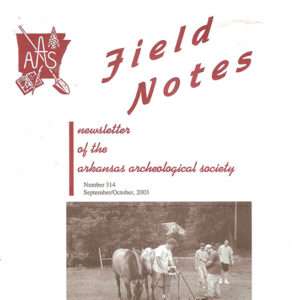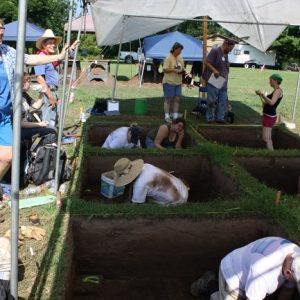calsfoundation@cals.org
Arkansas Archeological Society
The Arkansas Archeological Society (AAS) is a statewide organization created for the purpose of uniting all persons interested in the archaeology of Arkansas, fostering the recognition and preservation of cultural heritage and prehistory, and encouraging the public’s interest in the preservation of the past.
There was an unsuccessful effort to form a similar society in 1932. Little is known of this organization because it produced no publications and relied solely on semi-annual meetings to bring the membership together.
The current AAS was formed in 1960. Its primary founders were Samuel C. Dellinger (president); Harry McPherson, Cecil Cleavenger, Marvin Riddle, and H. Dudley Glass (vice presidents); Dr. Charles R. McGimsey III (secretary and newsletter editor); and Hester Davis (treasurer). It was apparent to the organization’s founders that the archaeological history of Arkansas was being rapidly destroyed or removed by public and private collectors, highway construction, development projects, dam construction, and an expanding agricultural industry. The first AAS newsletter (issued in January 1960) devoted considerable space to the need for archaeological training and preservation, as well as for information on archaeological sites and artifacts to be exchanged and permanently recorded.
The AAS has several local chapters that meet monthly to hear presentations on archaeology. Many chapters are associated with Arkansas Archeological Survey research stations and assist with archaeological projects, laboratory work, and excavations. There are currently eight chapters: the Arkansas River Valley Chapter based on Petit Jean Mountain near Morrilton (Conway County), the Central Mississippi Valley Chapter in Jonesboro (Craighead County), the Kadohadacho Chapter in Magnolia (Columbia County), the Ko-ko-ci Chapter in Fayetteville (Washington County), the Ouachita Chapter in Hot Springs (Garland County), the Toltec Chapter in Little Rock (Pulaski County), the Tunican Chapter in Monticello (Drew County), and the Ark-Homa Chapter in Fort Smith (Sebastian County).
Each fall, the society holds an annual meeting to share news of archaeological events, hear papers on current archaeological topics, and hold a business meeting. During the annual meeting, an evening banquet features an address by a guest speaker. The society bestows several awards to members and non-members who have made outstanding contributions to Arkansas archaeology and preservation. Certificates of appreciation are presented to individuals, groups, or organizations that support the purpose and goals of the society. A silent auction raises funds for the Archeological Research Fund; this fund pays for portions of archaeological projects that have included society members where no other funding sources exist.
The society publishes the newsletter Field Notes six times a year. Its annual bulletin, The Arkansas Archeologist, contains scholarly articles and research papers. The Arkansas Archeological Survey publishes an annual report that includes a summary of their activities and activities done in coordination with the society.
For about sixteen days each June at a significant archaeological site in Arkansas, the AAS and the Arkansas Archeological Survey sponsor a program of archaeological excavations, research, and training called the Archeological Training Program. The program grew out of weekend excavations that began in 1964 under the direction of University of Arkansas Museum archaeologists and society members. By 1967, the Arkansas Archeological Survey assumed partnership with the society from the museum. In 1972, the training program expanded to sixteen days in order to accommodate seminars and other formal training in archaeology that leads to archaeological certifications. There are three progressive training levels that culminate in becoming a Certified Archeological Technician. Technicians may be awarded a Field Archeologist certificate for completion of a research project and publication. Certificates for the completion of the program are awarded at the annual meeting.
Archaeological site stewards are utilized throughout Arkansas to help monitor and protect sites on private and public property by working with landowners and property managers to preserve their archaeological resources better. Stewards attend a three-hour workshop offered annually at the training program.
The AAS sponsors Arkansas Archeology Month each March to increase the public’s interest and understanding of archaeological resources. Society chapters, public institutions, and other groups schedule programs, exhibits, and activities that promote Arkansas archaeology or the archaeology month theme. The event began in 1991 as Arkansas Archeology Week and was expanded in 1992 to a month.
For additional information:
Arkansas Archeological Society. http://www.arkarch.org (accessed February 15, 2022).
Swadley, Ben H. “The History of the Arkansas Archeological Society and its Central Arkansas Chapter.” Pulaski County Historical Review 58 (Summer 2010): 47–53.
“Why an Arkansas Archeological Society?” Newsletter: Arkansas Archeological Society 1 (1960): 1–3.
Ben Swadley
Scott, Arkansas
 AAS Membership Form
AAS Membership Form  The Arkansas Archeologist
The Arkansas Archeologist  Field Notes
Field Notes  Mound Excavations
Mound Excavations  Plum Bayou Mounds Excavation; 2010
Plum Bayou Mounds Excavation; 2010  Plum Bayou Mounds Excavation; 2010
Plum Bayou Mounds Excavation; 2010 




Comments
No comments on this entry yet.